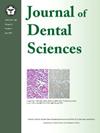特发性髁突吸收患者咀嚼肌动态增强磁共振成像
IF 3.1
3区 医学
Q1 DENTISTRY, ORAL SURGERY & MEDICINE
引用次数: 0
摘要
背景/目的特发性髁突吸收(idiopathic condylar reption, ICR)是颞下颌关节疾病(TMDs)的一个亚型,下颌髁突结构改变与咀嚼肌灌注改变之间的关系尚不清楚。本研究旨在利用动态对比增强(DCE)磁共振成像(MRI)技术探讨ICR患者下颌髁突结构变化与咀嚼肌灌注的相关性。材料与方法2018年7月至2022年8月,对医院TMD诊所的ICR患者进行常规和DCE MRI检查。根据患者颞下颌关节(TMJ)髁突吸收程度分为0级(正常)、1级(轻至中度)和2级(严重)。检查负责闭口(咬肌[MA]和翼状内侧肌[MP])和开口(翼状外侧肌[LP])的咀嚼肌DCE MRI参数。结果79例患者(158例)中,41%为0级组,29%为1级组,30%为2级组。两组间在人口统计学或体质参数上没有显著差异。在严重的髁突吸收(2级)的情况下,LP肌肉的血浆体积明显增加;其他肌肉的血浆量没有明显变化。结论LP肌血浆容量灌注增加与TMJ髁突吸收严重程度相关,提示肌肉功能与ICR严重程度有特定的相关性。DCE MRI可用于研究ICR和tmd患者的肌肉适应性。本文章由计算机程序翻译,如有差异,请以英文原文为准。
Dynamic contrast-enhanced magnetic resonance imaging of masticatory muscles in patients with idiopathic condylar resorption
Background/purpose
Idiopathic condylar resorption (ICR), a subset of temporomandibular disorders (TMDs), presents an unclear relationship between structural changes in the mandibular condyle and alterations in masticatory muscle perfusion. This study aimed to investigate the correlation between mandibular condyle structural changes and masticatory muscle perfusion in patients with ICR using dynamic contrast-enhanced (DCE) magnetic resonance imaging (MRI).
Materials and methods
From July 2018 to August 2022, patients with ICR from hospital-based TMD clinics underwent conventional and DCE MRI examinations. The patients were categorized on the basis of the degree of temporomandibular joint (TMJ) condylar resorption into grade 0 (normal), grade 1 (mild to moderate), and grade 2 (severe). DCE MRI parameters of masticatory muscles responsible for mouth closing (masseter [MA] and medial pterygoid [MP]) and opening (lateral pterygoid [LP]) were examined.
Results
Among 79 patients (158 TMJs), 41 % were assigned to the grade 0 group, 29 % were assigned to the grade 1 group, and 30 % were assigned to the grade 2 group. No significant differences in demographic or physical parameters were observed between the groups. In cases of severe condylar resorption (grade 2), the LP muscle exhibited a marked increase in plasma volume; none of the other muscles exhibited significant variations in plasma volume.
Conclusion
Increased plasma volume perfusion of the LP muscle is correlated with the severity of TMJ condylar resorption, indicating a specific correlation between muscle function and ICR severity. DCE MRI is useful for exploring muscular adaptation in patients with ICR and TMDs.
求助全文
通过发布文献求助,成功后即可免费获取论文全文。
去求助
来源期刊

Journal of Dental Sciences
医学-牙科与口腔外科
CiteScore
5.10
自引率
14.30%
发文量
348
审稿时长
6 days
期刊介绍:
he Journal of Dental Sciences (JDS), published quarterly, is the official and open access publication of the Association for Dental Sciences of the Republic of China (ADS-ROC). The precedent journal of the JDS is the Chinese Dental Journal (CDJ) which had already been covered by MEDLINE in 1988. As the CDJ continued to prove its importance in the region, the ADS-ROC decided to move to the international community by publishing an English journal. Hence, the birth of the JDS in 2006. The JDS is indexed in the SCI Expanded since 2008. It is also indexed in Scopus, and EMCare, ScienceDirect, SIIC Data Bases.
The topics covered by the JDS include all fields of basic and clinical dentistry. Some manuscripts focusing on the study of certain endemic diseases such as dental caries and periodontal diseases in particular regions of any country as well as oral pre-cancers, oral cancers, and oral submucous fibrosis related to betel nut chewing habit are also considered for publication. Besides, the JDS also publishes articles about the efficacy of a new treatment modality on oral verrucous hyperplasia or early oral squamous cell carcinoma.
 求助内容:
求助内容: 应助结果提醒方式:
应助结果提醒方式:


